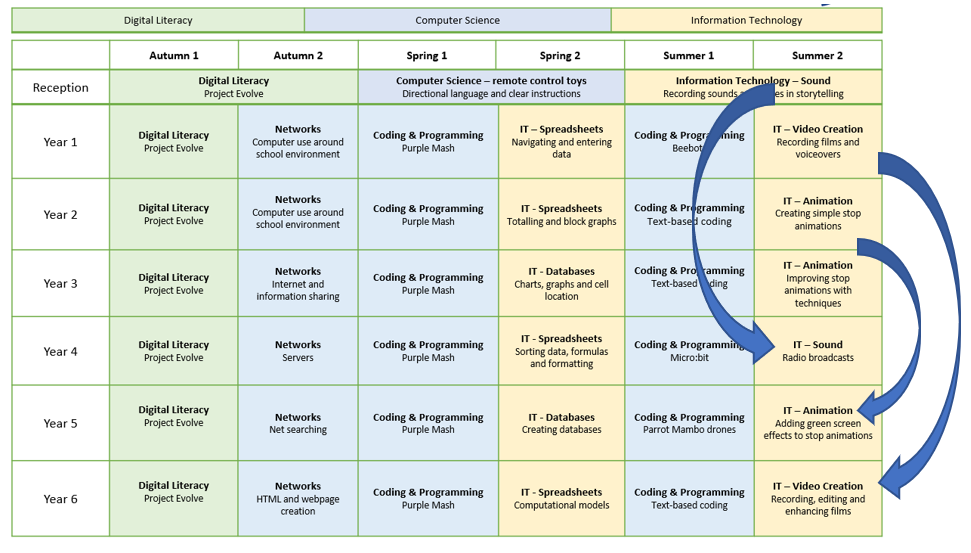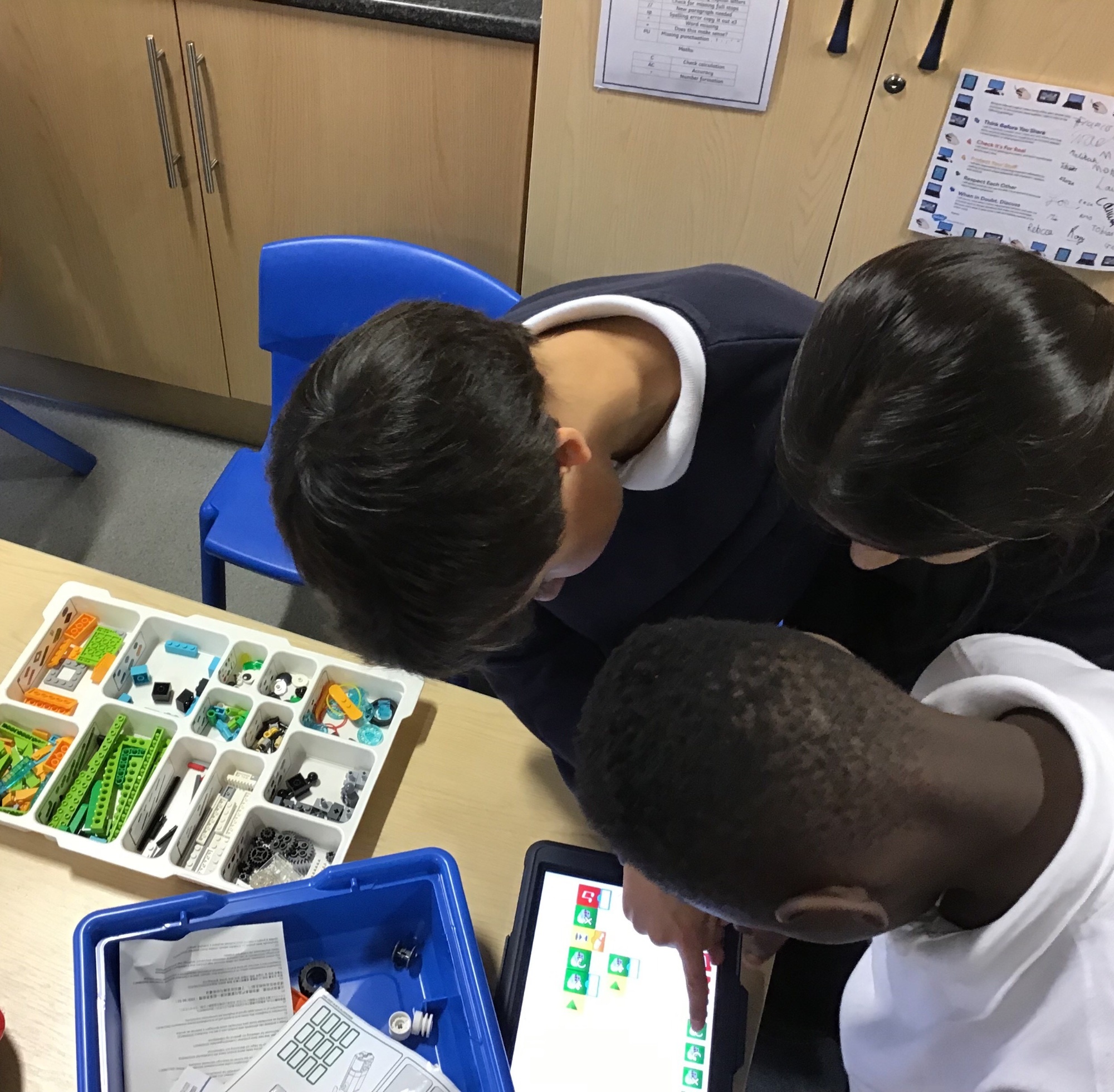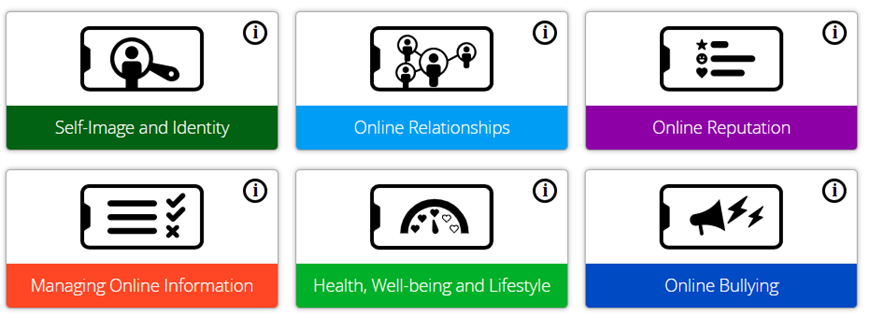Computing
Computing at West Didsbury CE
Our curriculum aims to enable children to become “active participants in our increasingly digital society” (Royal Society, 2017). Computing is part of our daily life within school and can therefore provide a wealth of learning opportunities and transferrable skills. These skills are taught explicitly within Computing lessons and are revisited and consolidated across other curriculum subjects. Through the study of Computing, children will be able to develop a wide range of fundamental skills, knowledge and understanding that will actually equip them to safely navigate the digital world.
Key Concepts
All learning from Reception to Year 6 is categorised within our 3 key concepts – Digital Literacy, Computer Science and Information Technology.

How learning is sequenced
We have a strong focus on Computer Science (the units in blue). From Year 1, children learn to programme on Purple Mash using a block-based language. This is revisited each year with increasing complexity and provides a strong schema. To avoid the pitfall of becoming dependent on block-based languages, children also learn how to code in text-based languages in years 2, 3 and 6.
Our creative IT curriculum provides children the opportunities to create digital artefacts in sound, video and animation. Building blocks are secured in EYFS and KS1 and expanded on in KS2.
 In EYFS, we aim to give children a broad, play-based experience of computing in a range of contexts, including outdoor play. Early years learning environments enable children to interact with computing scenarios based on experience in the real world. Children gain confidence, communication and language skills through indoor and outdoor exploration with technological resources such as remote-controlled toys, Ipads and telephone sets. Children will begin to develop spatial reasoning and understanding of technology in our diverse world.
In EYFS, we aim to give children a broad, play-based experience of computing in a range of contexts, including outdoor play. Early years learning environments enable children to interact with computing scenarios based on experience in the real world. Children gain confidence, communication and language skills through indoor and outdoor exploration with technological resources such as remote-controlled toys, Ipads and telephone sets. Children will begin to develop spatial reasoning and understanding of technology in our diverse world.
In Key Stage 1, children begin to recognise the common uses of information technology within school and how technology impacts their lives and the wider community. The children work collaboratively to use technology purposefully and begin to build their programming, creativity and logical reasoning. There is strong focus on keeping safe, privacy and how to communicate when encountering problems.
In Key Stage 2, the children will continue to be responsible, competent, confident and creative users of information and communication technology. They will recognise the need to remain aware of potential uses of any emerging technologies. Children will build upon technical vocabulary to further deepen their understanding. They are taught to design and build programs, develop ideas and create a range of content across different platforms. They will consider the deep links with mathematics, science and design and technology and how these provide insights into both natural and artificial systems.
Computational thinking
 When pupils solve problems in computing, this is often described as computational thinking (CT). CT lacks a clear definition which makes explicit teaching difficult. Grover & Pea (2018) have produced a list of concepts and practices related to CT, including: logic and logical thinking; algorithms and algorithmic thinking; patterns and pattern recognition; abstraction and generalisation; evaluation; and automation.
When pupils solve problems in computing, this is often described as computational thinking (CT). CT lacks a clear definition which makes explicit teaching difficult. Grover & Pea (2018) have produced a list of concepts and practices related to CT, including: logic and logical thinking; algorithms and algorithmic thinking; patterns and pattern recognition; abstraction and generalisation; evaluation; and automation.
Tricot and Sweller argue that teaching generic skills does not work and ‘learned skill, especially problem-solving skill, derives primarily from the accumulation of a large store of domain-specific knowledge stored in long-term memory’ (2014). Our pupils therefore acquire CT skills through procedural tasks such as coding and programming. By having a go, making mistakes, learn from them and overcoming obstacles, these CT skills are continually strengthened from EYFS to Year 6.
Digital Literacy and E-safety
The National Centre for Computing Education defines digital literacy as the ‘skills and knowledge required to be an effective, safe and discerning user of a range of computer systems’ (2021). We use ‘Project Evolve’, an award-winning scheme derived from the UK Council for Internet Safety's (UKCIS) framework ‘Education for a Connected World.’
The topics below are revisited each year at an age-appropriate level. Digital literacy and e-safety is reinforced in PSHE, particularly in Years 5 & 6, as children begin using technology more frequently outside of school.

‘Empowering knowledge’
Knowledge of how computing is used purposefully is ‘empowering knowledge’ as it sets out the profound impact it has had on humanity. We are continually reviewing our curriculum to find ways we can demonstrate this, for example in Year 6 when learning about the Second World War, we highlight the early use of computers such as Colossus, which contributed to saving lives during the war effort.
We are also keenly aware of the gender imbalance in computing. The Wellcome Trust found that less than half the number of girls find the subject interesting compared with boys (2020). Other research states that over a quarter of female respondents said that the subject is boring and nearly a fifth said that they lack interest (2018). This lack of engagement may partly come from lack of confidence so we have a strong focus on encouraging and praising girls’ achievements and efforts in computing.

